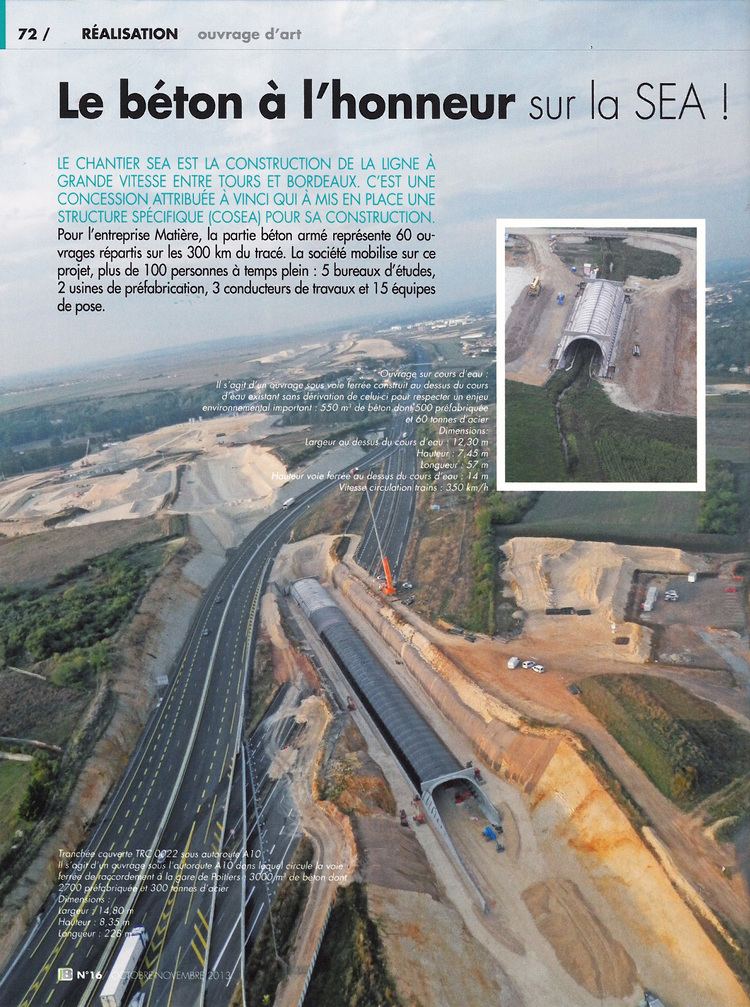 | ||
Lgv sud europe atlantique tours bordeaux pose des rails
The LGV Sud Europe Atlantique (LGV SEA), also known as the LGV Sud-Ouest or LGV L'Océane, is a high-speed railway line between Tours and Bordeaux, in France. It will be used by TGV trains operated by SNCF, the French national railway company. It is an extension of the LGV Atlantique. The line was inaugurated on 28 February 2017 is expected to enter service on 2 July 2017. The line was built by consortium LISAE, which will be responsible for operating and maintaining the line until 2061.
Contents
- Lgv sud europe atlantique tours bordeaux pose des rails
- Des photographes sur le chantier de la lgv sud europe atlantique
- Purpose
- Details
- Phases
- Phase 1 AngoulmeBordeaux
- Phase 2 ToursAngoulme
- History
- References
Des photographes sur le chantier de la lgv sud europe atlantique
Purpose
The LGV SEA will bring high-speed rail service to southwestern France and connect the régions of Poitou-Charentes, Aquitaine and Midi-Pyrénées with the high-speed rail service of Northern Europe, which connects Paris to London, Brussels, Amsterdam and beyond. The trip between Paris and Bordeaux will take around two hours and ten minutes at a projected speed of 300 km/h. The inter-city links between Tours, Poitiers, Angoulême, and Bordeaux will also be improved and southwestern France will be better connected to various parts of the country and to the rest of Europe.
The project is also a response to the heavy traffic on the existing rail line. Train tracks are most efficiently used when all trains circulate at the same speed and have identical stops. The large speed difference between the fast TGV trains, which circulate on the existing tracks at speeds up to 220 km/h, and the slower freight trains and TER (regional) trains, which share the same track, forces to greatly increase the interval between these trains. This congests the tracks and prevents their most efficient usage.
Dedicated tracks for the TGV therefore leave space on the existing tracks for many more freight and TER trains than just the number of removed TGV trains. New regional TER services will become possible, and could ease services that are currently crowded. The increase in freight trains on the existing track would ease truck traffic on the roads in the régions, as trains transport more and more goods, easing the impact on the environment as well.
The project was also sold as benefiting the economy. The construction of Phase 1 is expected to create 10,000 construction jobs a year for five years. Jobs in the transport, commerce, and service sectors are expected to be created as well. Local businesses may their see competitiveness increase as their markets expand, and tourism to the region may increase as well.
This route will supplement – and partly supersede – the classic Paris–Bordeaux railway line.
Details
The line was built by consortium LISEA consisting of Vinci Concessions (Vinci SA subsidiary) - 33.4%, Caisse des dépôts et consignations - 25.4%, Meridiam - 22.0% and Ardian - 19.2%. The consortium will be responsible for operating and maintaining the line until 2061. The consortium invested €3.8 billion, French governmentm local authorities and the European Union paid €3 billion and €1 billion was contributed by SNCF Réseau (subsidiary of SNCF.Another €1.2 billion was spent by SNCF Réseau on the construction of interconnecting lines, control centres, capacity enhancements at Bordeaux and remodelling the track layout at Gare Montparnasse.
The new high-speed route is bypassing Libourne, shortening the total distance traveled compared to the existing route. No new train stations were built between Saint-Pierre-des-Corps and Bordeaux, service to Châtellerault, Poitiers and Angoulême will take advantage of existing train stations, with connections allowing access to the high-speed rails. South of Poitiers, a connection is allowing trains to access the old tracks towards La Rochelle.
The journey between Tours and Bordeaux will be shortened by around 50 minutes. 302 km of high-speed track was built together with a further 38 km of conventional tracks that connect to the LGV. The new line is expected to increase annual ridership by about five million travellers.
Phases
For financial reasons, the project was initially divided into three phases:
Phase 1: Angoulême–Bordeaux
Phase 2: Tours–Angoulême
In that initial plan, Phase 2 had to be completed on a rapid schedule to cope with the increased in traffic expected after the opening of Phase 1. For this reason the French government announced additional funding in February 2009 to build Phases 1 and 2 together.
On 30 July 2010, the French government announced that work on the section to the Spanish border is expected to begin before 2020. In 2015 however, a public inquiry rejected the construction of this section due to cost.
